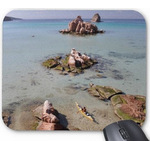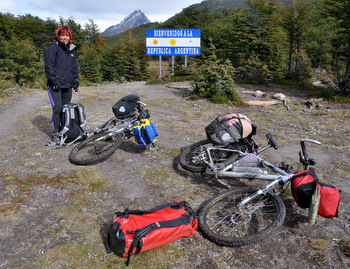• Logbook
• Road Stars
Download GPS file from El Chaltén to Villa O'Higgins crossing:
• GPS track & waypoints
The crossing from El Chalten (Argentina) to Villa O'Higgins (Chile) is one of the ideal routes for cyclists. Includes a 23 mi dirt track from El Chalten to the southern tip of Lago del Desierto, a ferry that transports you to the northern tip of the lake, where the Argentinean Gendarmes post is. From here a trail in poor condition and a pit bog forces you to push and drag the bike plus ford several rivers. When you reach the pass and cross into Chile, a good dirt track takes you to the Carabineros post on the shore of Lago O'Higgins. From there, another ferry takes you across the lake to the port of Villa O'Higgins, a few miles from town. It would be perfect if the Argentinians improved the trail and turned it into a track, but for now we have to walk the bike up the hill.
Stage index:
March 22: From El Chaltén to Lago del Desierto (Profile)
March 23: From Lago del Desierto to Candelario Mancilla (Profile up) (Profile down)
March 24 & 25: Stranded in Candelario Mancilla
March 26: From Candelario Mancilla to Villa O'Higgins
March 22, 2011: From El Chalten to Lago del Desierto
We cannot wait for the good weather any longer. This season there are only 2 more crossings left for the ferry across Lake O'Higgins: tomorrow and next Saturday. Autumn has definitely arrived. Temperatures have dropped significantly. After several days of rain, the snow covers the mountains. El Chaltén is preparing to hibernate. Like many other tourists, we leave the village to continue our trip.
Although it’s windy and the sky is overcast, it´s not raining. The road follows the River de las Vueltas upstream, towards Lago del Desierto, strange name for a lake in an area so green and humid. As we go deeper into the valley and leave civilization behind, I get a feeling of having taken the wrong way. The surrounding mountains are covered with snow from a level not much above the road. Occasionally, the wind brings snowflakes, warning us that somewhere nearby is snowing. A hole in the cloud layer lets the sun pass, illuminating the end of the valley where we are heading. It almost looks like a trap.
The 23 miles to the southern end of Lago del Desierto pass quickly, on a track in good condition. The Huemul, our ferry leaves at 5 PM, but it´s 2 PM. According to all the locals, fishing here is great, so I spend a couple of hours fishing until I almost freeze. With empty hands I give up and go to the hut of the camping near the lake, where Judit has been chatting with couple in charge and a group of tourists. The room is very small and so many people I find it too crowded. Luckily, the tourists are leaving back to El Chaltén. We stayed chatting with Carla and David and also taste the zucchini empanadas that she has just prepared. David notes the Huemul horn is calling for the passengers. That means us.
On this side of the lake, the wind is fairly calm and the waves are small. Halfway, in an area where the lake narrows, the wind is funneled and not only generates significant waves, but also blows away water from the surface at high speed. Our captain changes course frequently to negotiate higher gusts. Upon reaching the north end, everything is calm again. We can even enjoy a dim sun for a few minutes. The gendarme who stamps our passports shows us the first section of the trail that we will follow tomorrow to get to the border.

March 23, 2011: From Lago del Desierto to Candelario Mancilla
Today has been full of emotions and surprises, most of them pleasant. The first part of the day consists of pushing the bike up the trail to the pass that marks the border between Argentina and Chile. Then ride down to Candelario Mancilla port on Lake O'Higgins´s shore and then crosse by ferry to Villa O'Higgins. Or at least that was the plan...
When we are loading the panniers on the bikes, a guy from the other tent in the campground shows up. It turns out he´s another rider who yesterday made our same route but in the opposite direction, as we did 6 years ago. Once again, he warns of the difficulty of the climb, the mud and several rivers to be forded. Yes, we know. And we know that it’s easier in the other direction. We thank you him for his concerns and the latest information and set off. Today we have packed differently than usual. We carry the heaviest items on the backpack. Thus, the panniers are lighter and will be easier to push and maneuver the bike.
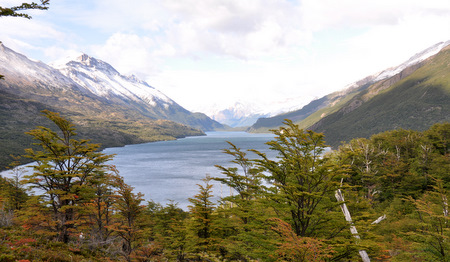

Our biggest fear was certainly the pit bog everybody was talking about: 50 yards where "you get into the mud up to the knees". When we get to it, we explore around and find an alternative route that avoids the worst section. Surprised by how easy it was, we are not convinced this is it and maybe we'll find it later. A few hundred yards ahead we reach the southern end of the Laguna Larga, indicating that the pit bog is over. This encourages us again. At this point we have covered 2 miles in 2 hours and a half. The lagoon is also indicative that the trail levels because goes around it. However, this section becomes a muscle-breaker by the numerous times the trail goes up and down to avoid obstacles like too steep side slopes, streams and fallen trees. After a total of 3.75 miles and 4 hours of bike-pushing, we get to the signs for no man's land. In front of us it reads "Welcome to Chile. Aysen Region". Behind us "Welcome to Argentina". Between them is the milestone that marks the border. We are very happy and we celebrate it with some yummy alfajores stuffed with dulce de leche and covered in chocolate.
Judit goes ahead on foot to check if behind those trees it is actually the track that will lead us to Lago O'Higgins. Yes, indeed, the trail becomes a vehicle track in decent condition that will allow us to move much faster. Is 1:30 and we have 10 miles till the police checkpoint. We should have enough time since our ferry leaves at 5.
We have not yet ridden 50 yards when we cross two French girls pushing their bikes up. This is disturbingly surprising. If they are coming up today is because they have crossed from Villa O'Higgins today. We were told by phone, the ferry should arrive about 4 at the earliest. The doubts are revealed when the girls report the ferry left shortly after arriving. There must be some confusion, or more than one vessel. To give you an idea, Candelario Mancilla is not a village, only a police station and a tiny estancia. If the ferry has really arrived and left today, the next does not come until Saturday, and it’s also the last of the season. The idea of being stranded in Candelario gives us the creeps, so we resume pedaling without wasting any more time.
The dirt road should go down (as we remember), but it has continuous ups and downs. The truth is that it doesn’t sound familiar at all. We are relieved to see bike tracks that can only come from the port. Another pleasant surprise that we find on the way is the existence of a bridge across the River Obstáculo. The last time we went through here it was destroyed and we had no choice but to get wet. Another novelty is that the road now goes on the side of a dirt airstrip for military use. When we are about 3 miles from our destination, the road descends in a clear and uninterrupted downhill. I would love to get rid of the panniers and fly down at full speed. Although we have to negotiate rocks, puddles and mud, moving forward without pedaling is a luxury. A couple of miles from the end, we crossed several trucks and a bulldozer. One of the drivers tells us the boat that left today is property of the government and used to transport materials and vehicles for the road maintenance. Now we are really confused. We didn´t know of the existence of a second boat. We were going to take the passengers boat, not the government one. Our fears are confirmed upon arrival at the police checkpoint. While they formalize the procedures for passports, were besieged them with questions about possible crossings. The only that they know of is next Saturday. Ours was yesterday. That boat was for locals, so we assume that the date was changed at their convenience and our misfortune. The crossing for tourists is Saturday. We are stranded in Candelario Mancilla for 3 days! The only possibility is that the barge for the road maintenance comes again on Friday but will not know this for sure until Thursday.
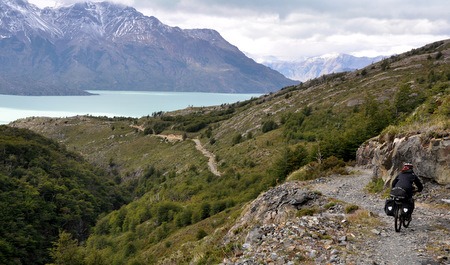
March 24 and 25, 2011: Stranded in Candelario Mancilla
Candelario Mancilla is not a village, just a carabineros outpost to demonstrate sovereignty in the area. In addition to the border post, there is only one small estancia that provides camping. There is nothing else for miles around. During this week and the next one the place is more crowded than usual due to the group of road workers repairing the track. In fact, every evening they pick up some tourists they find along the road. On our second day of captivity, the carabineros offered to a French couple, completely wet, the house where we are staying. With them we share long hours of confinement.
Besides taking the time to read, write and plan, there are some unsuccessful fishing attempts. The most rewarding moments are the ones we shared with the carabineros. In addition to tea, one day we have lunch together. They prepare pork chops and we prepared a Spanish omelet. Gradually, the house we make the house our home. We light the wood stove, use the electric water heater for our tea...
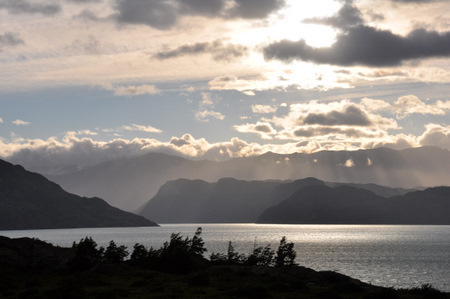
After a long chat after dinner with them, we go to bed. While the logs crackle in the fireplace and the glow of fire dimly lit the hallway and our room, we fell asleep thinking about tomorrow. In theory, both the barge and the tourist boat have to come. But there are several reasons why that may not happen, especially if the wind that hasn’t stopped blowing increases.
March 26, 2011: From Candelario Mancilla to Villa O'Higgins
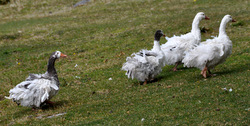
Today everything is on track, at 10 we are at the harbor with other 6 passengers. The Quetru arrives, leaving a group of cyclists and goes to the glacier. We confirm that it will come back at 5 PM. While we wait for the barge, we return to the carabineros post and at that time appears the helicopter that should have come yesterday. We approach it to look around and we start a conversation with the pilot and flight assistant. Their mission is to transport personnel and material to the ice field where a group of soldiers are going to install a shelter for the study of the continental ice.
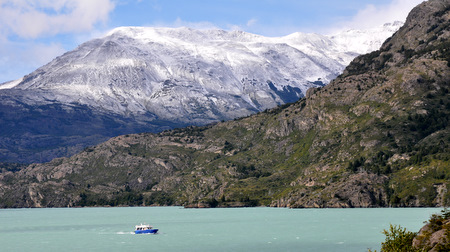
When we finally jump aboard the Quetru, we breathe in peace. Immediately after leaving the quiet of the cove, the waves attack the boat and I have to go to sleep to avoid getting dizzy. I just wake up one roll out of the ordinary or the splash of waves on the windows. During the last stretch, once deep in the arm of Villa O'Higgins and calmer waters, we watch a video with images of Aysen, the region we are entering.
When we arrive at the Bahamondez harbor it’s already dark and raining. Very kindly, the captain takes us on his pick-up truck to town, some 8 mi from the port. We stay at the Mosco, a hostel owned by Jorge, a Galician who settled in Villa a few years ago. They we also know Paqui, a girl from Mallorca who has spent several months backpacking through Europe and South America. With them we talk till late into the night while trying to use the free WiFi that reaches all the village. The escape from Candelario is now a reality.


